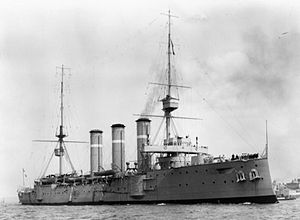HMS Cumberland (1902)

Cumberland at anchor
|
|
| History | |
|---|---|
|
|
|
| Name: | HMS Cumberland |
| Namesake: | Cumberland |
| Builder: | London and Glasgow Shipbuilding, Govan |
| Laid down: | 19 February 1901 |
| Launched: | 16 December 1902 |
| Completed: | 1 December 1904 |
| Decommissioned: | Paid off, April 1920 |
| Fate: | Sold for scrap, 9 May 1921 |
| General characteristics | |
| Class and type: | Monmouth-class armoured cruiser |
| Displacement: | 9,800 long tons (10,000 t) (normal) |
| Length: | 463 ft 6 in (141.3 m) (o/a) |
| Beam: | 66 ft (20.1 m) |
| Draught: | 25 ft (7.6 m) |
| Installed power: |
|
| Propulsion: |
|
| Speed: | 23 knots (43 km/h; 26 mph) |
| Complement: | 678 |
| Armament: |
|
| Armour: | |
HMS Cumberland was one of 10 Monmouth-class armoured cruisers built for the Royal Navy in the first decade of the 20th century. She was assigned to the 2nd Cruiser Squadron of the Channel Fleet upon completion in 1903. After a refit in 1907–08 she became a training ship in the Home Fleet. She was sent to West Africa after the beginning of World War I in August 1914 and captured 10 German merchant ships in September. Cumberland spent the rest of the war on convoy escort duties and patrolling for German commerce raiders. She was sold for scrap in 1921 and broken up two years later.
Cumberland was designed to displace 9,800 long tons (10,000 t). The ship had an overall length of 463 feet 6 inches (141.3 m), a beam of 66 feet (20.1 m) and a deep draught of 25 feet (7.6 m). She was powered by two 4-cylinder triple-expansion steam engines, each driving one shaft, which produced a total of 22,000 indicated horsepower (16,000 kW) and gave a maximum speed of 23 knots (43 km/h; 26 mph). The engines were powered by 31 Belleville boilers. She carried a maximum of 1,600 long tons (1,600 t) of coal and her complement consisted of 678 officers and enlisted men.
Her main armament consisted of fourteen breech-loading (BL) 6-inch Mk VII guns. Four of these guns were mounted in two twin-gun turrets, one each fore and aft of the superstructure and the others positioned in casemates amidships. Six of these were mounted on the main deck and were only usable in calm weather. They had a maximum range of approximately 12,200 yards (11,200 m) with their 100-pound (45 kg) shells. Ten quick-firing (QF) 12-pounder 12 cwt guns were fitted for defence against torpedo boats.Cumberland also carried three 3-pounder Hotchkiss guns and two submerged 18-inch torpedo tubes.
...
Wikipedia
